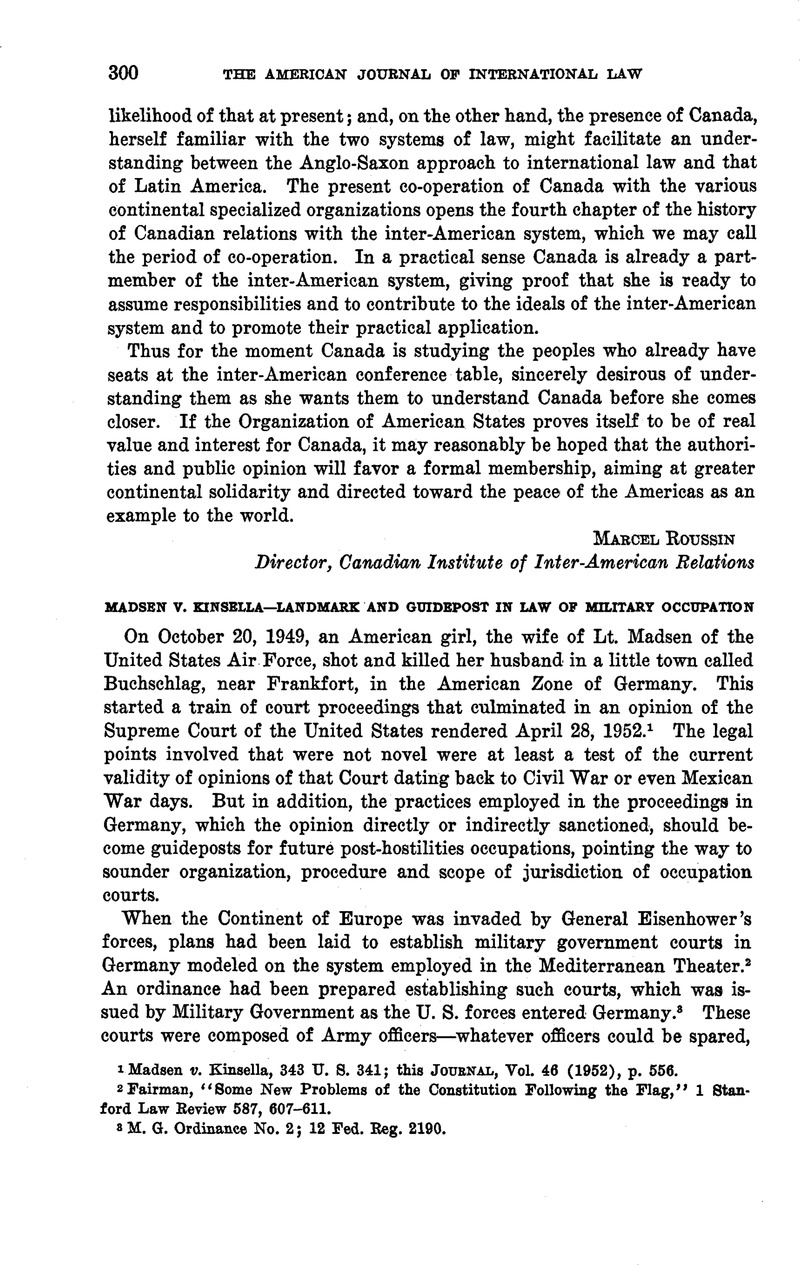No CrossRef data available.
Article contents
Madsen v. Kinsella–Landmark and Guidepost in Law of Military Occupation
Published online by Cambridge University Press: 20 April 2017
Abstract

- Type
- Current Notes
- Information
- Copyright
- Copyright © American Society of International Law 1953
References
1 Madsen v. Kinsella, 343 U. S. 341; this Journal, Vol. 46 (1952), p. 556.
2 Fairman, “Some New Problems of the Constitution Following the Flag,” 1 Stanford Law Review 587, 607–611.
3 M. G. Ordinance No. 2; 12 Fed. Reg. 2190.
4 This trend is reflected in the Legal and Judicial Affairs supplements to the Reports of the Military Governor.
5 Clay, Decision in Germany (1950), pp. 70–71.
6 Ibid., p. 65.
7 M. G. Law No. 2, Art. VI; 12 Fed. Reg. 2191.
8 14 Fed. Reg. 124.
9 Ibid. 128–133.
10 Hon. William Clark, formerly of the United States Court of Appeals for the Third Circuit. For a further discussion of this new military government court system see an excellent article by Judge Clark and Judge Thomas Goodman, also of the Military Government Court of Appeals and formerly of the Court of Appeals of Tennessee, entitled “American Justice in Occupied Germany,” 36 American Bar Assoc. Journal 443 (June, 1950). For a discussion of the earlier military government court system which was superseded by Ordinances 31, 32 and 33, see Nobleman, “American Military Government Courts in Germany,” Annals of American Academy of Political and Social Science (Jan. 1950), p. 87.
11 See Charter of the Allied High Commission (Dept. of State Bulletin, Vol. 21, No. 523 (July 11, 1949), p. 25, Notice of Entry into Force of Occupation Statute (14 Fed. Reg. 7456), and Executive Order 10062 (14 Fed. Reg. 2965).
12 U. S. High Commissioner, Law No. 1; 15 Fed. Reg. 2086.
13 See statement of the facts by the Court of Appeals in Germany, VIII Ct. of App. Rep. 495, 497.
14 Madsen v. Johnson et al., H. C. No. 3641.
15 Ex parte Quirin, 317 U. S. 1.
16 In re Yamashita, 327 U. S. 1; Johnson v. Eisentrager, 339 U. S. 763. The tribunals that tried the major Japanese and German war criminals are to be distinguished, since they have been held to have had an international character (Hirota v. MacArthur, 338 U. S. 197; Flick v. Johnson, 174 F. 2d 983, cert, den., 338 U. S. 879).
17 Santiago v. Nogueras, 214 U. S. 260, 266.
18 Mechanics’ and Traders’ Bank v. Union Bank, 22 Wall. 276; The Grapeshot, 9 Wall. 129.
19 Leitensdorfer v. Webb, 20 How. 176, 178.
20 Burke v. Miltenberger, 19 Wall. 519, 520.
21 Handlin v. Wickliffe, 12 Wall. 173.
22 188 F. 2nd 272, 274.
23 14 Fed. Reg. 2965.
24 63 Stat. 709, 712.
25 343 U. S. 341, 357.
26 See also Ex parte Quirin, 317 U. S. 1, where it was pointed out that such military tribunals need not have a jury, since they did not have one at the time of the adoption of the Constitution (pp. 38-40) and it was immaterial that one of those involved was a United States citizen (p. 20). There is no requirement of jury in territories ceded to, but not yet incorporated into, the United States (Balzac v. Porto Rico, 258 U. S. 298), much less in foreign lands which are merely under military occupation (Neeley v. Henkel, 180 U. S. 109) or in which we are permitted to maintain extraterritorial courts (In re Ross, 140 U. S. 453).
27 For the Articles of War, see 10 U.S.C. 1472 et seq.
28 343 U. S. 341, 345–355.
29 343 U. S. 341, 372.
30 343 U. S. 341, 355.
31 M. G. Proclamation No. 2; 12 Fed. Reg. 6997. 343 U. S. 341, 361–362.
32 93 F. Supp. 319, 327.
33 343 U. S. 341, 343.


